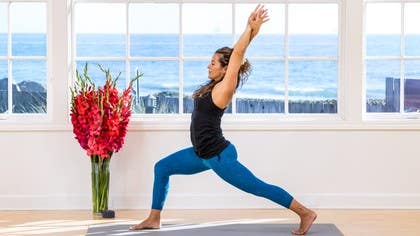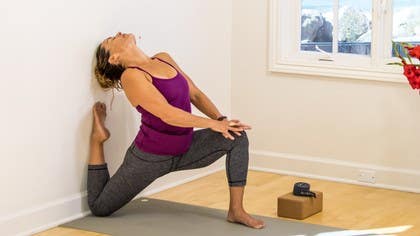Description
About This Video
Transcript
Read Full Transcript
(waves crashing) Greetings tribe, good to see you again, thanks for coming back and this practice is kind of a well-rounded practice using the wall, working towards some binding and Bird of Paradise bound ardha chandrasana. So let's enjoy together. We'll start with bringing the hands to the knees, comfortable seated position, and simply circling your spine over the basin of your hips. Some very simple hip swivels and it's one of my favorite ways to start to warm and open up the lower back and the hips is through circling, spiraling patterns. And if you'd like you can release your head, release your neck and just allow the head and the tail, the rib cage and the pelvis to kind of dance with each other for a couple of breaths here.
And then reverse the direction, just extending through the heart, pulling back through the hips and allowing those two structures, the pelvis and the ribcage to just massage the space, the soft space of the side waist, the low back and the belly. Relax your head, relax your neck. Enjoy how it feels. I'm taking one more cycle. And as you come up go ahead and sweep the left arm up and over into a side bend and ground down through the opposite hip.
Extend a little bit more through the top fingertips here, and your hand can be on the mat or you can lower down to your forearms just depending on what you are working with. And as you inhale, turn your heart towards the sky, kind of like how a sunflower turns towards the sun. As you exhale sweep the top arm forward and down, come in to a little mini twist here and just wrap your left arm behind your back and you can grab under your shirt, your waist, your inner thigh, open up your chest. Deep inhale here. Exhale.
Little bit deeper into the twist. And then simply release and we'll do the same thing with the second side. So sweeping the right arm up and over into a side bend. Palm or forearm grounding down onto the mat, opposite hip grinding down. As you inhale turn your chest to look towards the sky.
And then exhale to sweep forward and down and behind the back into a simple twist, a simple little half wrap here. Just feeling that internal rotation of the shoulder. So wonderful for healing for the rotator cuff and also all the muscles in the front of the chest that tend to get really tight from lots of chaturangas. Deep inhale here. Exhale a little bit deeper into a twist.
And then slowly release. And let's go ahead and roll on to the back just for a little bit of core work here to warm up the belly. Draw the knees into the chest. Interlace your fingers behind you. And we'll come into a really simple yogic bicycle here, bring the opposite elbow to opposite knee.
And you're welcome to press through your heels or through the balls of the feet or even a full point of the toes, just as long as there's energy through the feet. Sometimes I like to alternate. I'm really feeling the ends, warming map all the way through the little parts of your body. Let's pause to one side and extend your right leg towards the sky so you create a little capital letter L with your legs. As you exhale, bicycle pedal to the second side.
Stay lifted, stay twisted, and inhale left leg to the sky. And then exhale. And just continue this kind of slow extended yogic bicycle like you're moving through honey. Nice and slow. And working with the extension, the back of the leg, opening up the hamstring, opening up the breast and warming the core.
And we'll take three more rounds to each side. Last round. As you exhale draw the knees into the chest, release your head, neck and shoulders down and then place your feet on the mat, reach your arms over your head and you can kinda push yourself away from the wall here, create a little stability through the shoulder girdle. Tuck your tailbone under and lift your hips up, come in to a little counter pose from the core work, opening up the front of the hips. And sweep your arms down.
Let's lace the fingers or you can take a strap behind you if you like. And walk your outer shoulders in underneath you, so really opening up across the chest. Deep inhale here. As you exhale, hug the midline with your inner thighs and lift the tailbone, just the tailbone up, just a touch more. And one more full breath in.
And exhale slowly, separate hands and shoulders, roll on down your back. Hug your knees into your chest and let's rock and roll along the length of the spine a couple of times. And make your way back to downward facing dog. From your downward dog let's just take a couple of rounds of a classic vinyasa, as you inhale shift forward to plank. Exhale lower halfway down and hover in chatarunga.
Inhale to your back bend and really press the floor away to lift up through the heart. And exhale back to downward dog and just take that a couple more rounds here. And you're welcome to set your knees down if you like and lower all the way down moving through cobra. Or you can always hover in your classic vinyasa. Just bring in a little heat, little warmth into the shoulders and to the front of the body.
Exhale. I'm taking one more round to shift forward, lower down into your strength, rise up through your breath and then folding back. As you inhale, rise onto your toes. Bend the knees and step or lightly hop to your hands. And let's lift the heart halfway and exhale forward fold.
Inhaling to rise. And exhale hands to your heart. Just continue to circulate. Inhale to circle the arms out in that. Exhale to your forward fold.
Inhale lift your heart. Exhale release back into your forward fold. And then rise up again with a nice deep inhale, just circulating a couple half surya namaskars. Inhale expand. Exhale all the breath out as you fold.
Inhale to rise, look towards the horizon. Exhale fold. And inhale with an open heart, an enthusiastic heart. Come up, hands back to the center. And just take one more one like that.
Inhaling through the span. Exhale, diving in. Inhale to lift the heart. Exhale fold. Inhale to rise.
Exhale hands to your heart. Let's continue, move into our first progression from the wall. As you exhale forward fold. And then lift your chest and start to walk back to downward dog. And take yourself far enough back that your heels actually lightly touch the wall.
And you can lift the heels up slightly 'cause we'll be going into a crescent lunge. So your heels might be a little bit higher than they normally are in your downward facing dog. Take the right leg and just thread it up to the sky like an arrow. And then exhale step all the way through to your runner's lunge. And let's really make an effort to keep the back heel connected at the wall and the front knee over the front heel.
On an inhale come on up to crescent pose. And as you exhale, just as needed you might find when you come up that the front foot needs to move a little further back or a little further forward. And let's come and do a twist here. We're just gonna bring the outer right, excuse me, left tricep to the outer right thigh. So instead of stacking your palms, let's actually take the top hand to the bottom hand and start to turn the arm into a little internal rotation so you can pave the way for wrapping.
And you might come halfway and stay right there or you might go all the way underneath your thigh to the opposite side waist and then reach behind you for a little wrap. And if your spine rounds and kinda coils in to make the wrap, just do your best to elongate through your chest. Press into the back heel, forward through the heart and enjoy a couple of breaths here. Obviously it's always okay to lower your back knee if you like, otherwise you can keep it lifted, one more full breath. And then exhale release.
Start to press back to down dog but take your right foot to the wall. And since we're here at the wall we can just thread the left leg up and take a moment standing on our hands, opening up the chest, the shoulders towards the wall. And then bring it all the way back down into your downward dog. And we'll go right to the second side, let your left and right heels line up at the wall and thread the left leg up to the sky on an inhale. And exhale step it through to your crescent pose.
Inhale to rise. And exhale to your twist. And then give yourself a little time and space to work with this. My shoulders tend to be a little on the tighter side from swimming and surfing and just the way I was made. So I always have to kind of navigate a little bit and gently coax my body into any kind of wrapping and it takes time, right?
So wherever you are on that path hang with it. Maybe you're reaching around and grabbing just a finger or grabbing a wrist with one hand, but extend forward. Get long in your spine, long through the back leg if the knee's lifted. And let's take a couple of breaths. Last breath here.
Slowly release your hands. Press back towards a downward dog. Let's take the left foot to the wall. And then just pick it up and extend the right leg like a flag. Feels like a victory.
Over your head. And then slowly come back into your downward dog. And you can take it a little bit forward away from the wall and hang out here for a moment or two. From your downward dog go ahead and walk your hands back to your feet. Inhale, lift your heart halfway.
And then exhale, release, and roll up your spine one vertebra at a time. Surrender your shoulders, your head, your neck, and expand out in that big inhale. Exhale, hands to your heart. Let's go ahead and turn and face the wall and just line your hands up about shoulder width apart with about the level of your ribs. And then walk back to a little push wall or some folks refer to this as puppy dog.
It's just like downward dog, just like warrior three, just a different relationship to gravity. And from here we'll go ahead and extend the left leg back and up. And instead of opening the hips, let's work to keep the hips a little more square and drop the front ribs in to support the spine. So feeling a little vera bhadrasana three, a little downward dog, a little hands down, it's all inside of the shape. And then when we step back, we'll step back and land in warrior one.
So you're welcome to, if you have a really long mat, you can push right back into it. But otherwise adjust yourself as you need to to come into a nice deep vera bhadrasana one. Inhale to lift through the side waist and touch your palms. And then as you exhale open up into warrior two. And you can heel toe to front foot to the midline.
Let the back heel press down a little bit. Let's reach forward towards the wall, maybe touch it just for a moment. And then come into a little parsvakonasana. You can take a half wrap and hang out here on your elbow with your hand behind your back where you can come in a little deeper. And again just give yourself a little graciousness with the navigation here as you reach underneath.
It's not uncommon to bow forward to make the bind. And if that's happening just work towards realigning and upright your spine like a sunflower turning towards the sun. So draw the hip underneath you. Open your chest. And it helps to deepen the lunge a little bit here.
Deep inhale. Exhale, release. Take your hands towards the wall. Shift the right foot back just a touch and you can feel how the right leg is like, I need a little break. So we give it, we listen and we just take the weight off of our legs and into our hands.
You're welcome to use the wall for support. You're welcome to find your balance. You're welcome to skip that entirely and come on up and open your chest. Just depends on what you're feeling. And then as you exhale just turn back towards the wall.
Line up your hands with your rib cage. Press back. Coming in to push wall. And this posture is always a little bit interesting. It doesn't look like much.
But once we come into it and hold it for more than a couple of breaths, we find there's a lot of strength required, a lot of focus required to stay in this shape. And it helps us to find that navigation of the hips, the inner thigh, the length of the spine. Deep inhale as you push the wall away. Exhale, bend the standing legs, step back to your warrior one. Adjust your stance as you need to.
And come in really deep, really feel the rooting in the legs, rooting through the base and inhale to lift your heart. As you exhale, open up to your warrior two, adjust your front foot to the midline and find your base. Reach forward towards the wall, give it a little brush and either come in to your half wrap or reach down, shoulder goes to the inside of the knee. And again if you're bowing forward to reach underneath and make the bind, just realign. Whatever you're holding on to, sometimes people like to hold straps.
I've got a finger or two here, eventually your bottom hand will hold your to wrist. Roll the top shoulder open and just take a couple of breaths here. And then slowly release. Take your hands towards the wall, slice your left foot back just a touch. And your choice here, you can work on coming up for a little balance up the wall, right?
You can use the wall for balance. You can find your balance off the wall, just standing on the hands for a moment or two. And when you're ready come on down. Rise back up, open up your chest. Breathe into your heart.
And then from here we'll keep the right hand on the wall. And we'll into a little open hip variation of what we just did. So you can start to walk it back, almost like a one-armed push wall. And turn the hips open to come into this version of ardha chandrasana. Turn your chest open and roll the top hip on top of the lower hip.
You can turn your gaze if you like. Sometimes it feels a little more accessible to balance with your eyes on the earth. But it's good to periodically shift your gaze, maybe looking towards the side wall, or even looking up towards the sky. And if you'd like to bend your top knee and reach back and take the little toe side of your foot, you can start to open into a little bit of a back bend. And then slowly release, bring the left foot down and take your warrior two base up onto the wall.
So instead of if we were to take this shape and put it down on your mat, we'd be in a bit of a parsvakonasana, right? So just take it to the wall. Bring your right elbow inside your right knee and start to turn your chest open. And from here it just gives us a little more accessibility to start to work into the bird of paradise shape. So from here start to just turn your chest open away from your hip, away from your leg and slide in a little bit and kinda draw the shoulder down to the inside of the knee.
There's shades of that leg backpack here, but reach underneath. And the same thing when we were in our parsvakonasana, if you find that you're bowing forward to make the bind, just re upright your spine down to a nice shape. One of the things with any of the standing balance postures is the most important thing is that we're finding our tadasana, that we're standing up straight inside of the shape rather than kind of struggling down here. So lift your chest. And if that means keeping the knee bent and the foot on the wall then do that, right?
You can stay right here and you're basically in bird of paradise, you're in the shape of bird of paradise. And this is a great place to just start to feel the opening of the shoulders and the hips. And if you wanna work with balancing start to push off the wall with the ball of the foot. And you might catch a balance, you might go beyond your balance and fall down. But it's all right.
Just play with it a little bit and open the chest. And then when you're ready you can take the foot back to the wall and release. And we'll take the second side, just placing left hand on the wall about the same level as the rib cage and walking out into an open hip ardha chandrasana variation. And rolling the right half of the body open and feeling that long line of energy from your hand to the heel of the raised leg. Maybe adding a little quadricep opener here if you'd like and string in the bow.
And with the support of the wall remember you can start to work with just changing the gaze, slightly changes the proprioception inside of the shape, your connection of your brain to your nervous system. So all the wonderful parts of your body that are at work here. And then slowly release and bring in the right foot down. Take the left foot up to the wall, coming in to that warrior two base. Just slightly shift it up, and turning the chest open.
As you inhale stand a little taller. And as you exhale slide your shoulder inside of your knee, reach underneath, right arm reaches behind your back. If you're bowing forward re upright through your chest. Really wonderful opening through the heart, through the front of the right hip, even the inner thigh. You might stay right here, you might start to work with just pushing off the wall towards the balance.
Staying lifted, staying open through your chest, open through the shoulders. Pressing down through the bottom foot. And when you're ready just come back to the wall and release. So let's turn from here and just continue with that same shape but just slightly change it. So you can reach back and be about a leg length from the wall.
And we'll take the exact same shape bird of paradise, and just shift it, invert it basically for a bound ardha chandrasana. So separate your feet about hips width apart. Soften your knees and draw your hands down through the midline. And we'll draw the right shoulder inside of the right knee, open up through your wings, and then reach behind the back and come in to that same bound shape that we've been in several times through this practice. Bring your right foot to the midline.
And normally in a typical transition up to bird of paradise you'd shift and stand up. But let's actually keep the right foot down, shift your weight into the right foot and start to slide the opposite foot back to the wall. And you'll feel right away in your body if you need to adjust the standing leg further away from the wall or closer to the wall. So take the foot to the wall. And you can try to just feel in your body where hip height is with your left foot, keeping your gaze down on the earth or to straighten the bottom leg any amount.
And probably the sweetest part of this shape is the rotation of turning your chest towards the sky. Really grounding down through the feet, through the foot of the wall, through the foot on the earth, crown of the head dripping down towards the earth. Deep breath in. And then slowly, slowly release. Let your hands go first.
Take them to the mat and step the left foot down next to the right. Take a moment, bend your knees, come down into just a little squat here. It doesn't have to be a defined yogic squat, but just folding in the joints for a moment and then stretching on. Inhale to lift your hearts, separate the feet, let's go right to second side, so dive the left shoulder inside of the left knee. Open up your wings and reach around the hip for a little wrap.
Start to bring your left foot towards the midline. And then you can just slowly walk the right foot back to the wall. It's a bit of a blind entry. It always feels like where is that wall? It's back there.
And lean into it. Use the wall as you start to stretch your leg long. And the hip pulls in to the midline as you start to turn your chest open. Let's enjoy a couple of breaths here. Dripping down into gravity, reaching in opposite directions through your legs.
And then slowly release your hands to the earth. Bring in the right foot down. Separate your feet as wide as your mat. Turn the toes out, the heels in, and then sink down into malasana. Bring in the hands together with your heart.
Lift through the chest. Lift through the chin. And exhale bowing in. And just twice more inhale. Opening up the throat.
And exhale. Once more, inhale to the left. Exhale bowing in. Release your hands. Turn your palms face up.
Narrow the feet slightly if you like. We'll use the back of the neck. And let's hang out here. Let go of any effort in the body. We'll feel that wonderful opening through the hips and release through the back of the shoulders, back of the heart.
And let your last breath here be the deepest one. And then coming here to the seat, take your hands back behind you, lower your hips down and open up the knees for a baddha konasana. Go ahead and draw the heels in, open up the soles of the feet like a bug, press your knees down and lift through your chest. And as you exhale, just shifting your heart forward and imagining you're looking over the edge of a cliff into a river. Keep the outer hips, outer thighs active, so you press the knees down and sometimes we like to glide the elbows alongside the inner knees.
We can draw the elbows back and pull the heart forward. It's a very active posture, right? Press down with the knees and extend the spine long. And as you keep the length in your spine you can start to melt down any amount. Keep the posture active.
Keep the breath active. One more breath here. And then leading with your heart, leading with your inhale rising up. Extend your legs straight out in front of you. Give the legs and the knees a little shake, rattle and roll.
Flex your feet and reach up to the sky. And as you exhale coming in to simple paschimottanasana using a strap over your ankles or wherever you like to grab comfortably, if you'd like to take your toes, come into a toe lock here. So many options. And just like in our baddha konasana, continue to reach the heart forward rather than coiling in and rounding down, keep the length in the spine, length in the breath. And then on your next inhale slowly rise leading with the head, leading with the heart.
And exhale, bend the knees and set yourself up in a comfortable seated position. Sukhasana, cross legged, padmasana, full lotus or kind of a blend between the two sadasana, and let the backs of your wrists rest on your knees, sit tall. So when we interact with a lot of hip opening especially it allows us to sit a little more comfortably in sukhasana, right? All of our asana practice is simply a sweeping of the temple, sweeping of the temple, cleaning up, lighting the candles, preparing the space so that we can come and sit quietly and comfortably for a few moments of stillness. For many of us this can be the most challenging practice.
But for all of us if we can allow ourselves a moment or two, several moments, this can be the most profound and affect us more deeply than any complex asana that we move in and out of. So take a moment here and just allow some stillness in your body and some spaciousness between your thoughts. Let your breath rise like the incoming tide. And as you exhale the outgoing tide. Lift your neck, your shoulders and be like the slopes of a mountain top.
Anything that might be weighing on you, just let it drop down off the shoulders, tumble down the sides of the mountain. Please enjoy five simple breaths here, quiet stillness. Let your last breath be the deepest one. Exhaling completely, bring your hands to your heart. As you inhale just lift your hands up over your head into jaya mudra, the mudra of victory.
And as you exhale, just draw the hands from the crown to the heart symbolizing that connection of our brain waves to our heart waves, cutting through any delusions on the frontal brain. Let's just take that twice more and inhale to the crown, sahasrara chakra. And as you exhale to the heart, anahata chakra. Once more inhaling. Exhaling returning to your center.
And opening the eyes. Thank you so much for sharing your presence and your practice and your enthusiasm with me today. Namaste.
The Yoga Flow Show: Shelley Williams
Comments
You need to be a subscriber to post a comment.
Please Log In or Create an Account to start your free trial.













